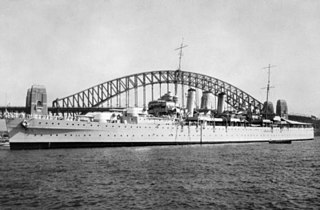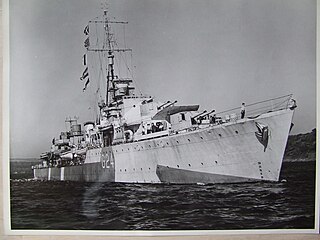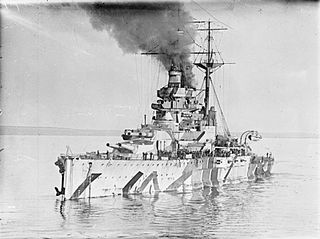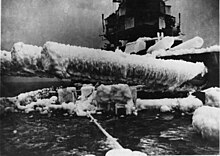
HMS Devonshire, pennant number 39, was a County-class heavy cruiser of the London sub-class built for the Royal Navy in the late 1920s. The ship spent most of her pre-World War II career assigned to the Mediterranean Fleet aside from a brief tour with the China Station. She spent the first two months of the Second World War in the Mediterranean until she was transferred to the Home Fleet and became flagship of a cruiser squadron. Devonshire took part in the Norwegian Campaign in mid 1940 and evacuated much of the Norwegian Government in June. Several months later, she participated in the Battle of Dakar, a failed attempt to seize the Vichy French colony of Senegal in September. The ship remained in the South Atlantic afterwards and supported Free French efforts to take control of French Equatorial Africa in addition to searching for German commerce raiders.

HMS Dorsetshire was a County-class heavy cruiser of the British Royal Navy, named after the English county, now usually known as Dorset. The ship was a member of the Norfolk sub-class, of which Norfolk was the only other unit; the County class comprised a further eleven ships in two other sub-classes. Dorsetshire was built at the Portsmouth Dockyard; her keel was laid in September 1927, she was launched in January 1929, and was completed in September 1930. Dorsetshire was armed with a main battery of eight 8 in (203 mm) guns, and had a top speed of 31.5 knots.

HMS Jamaica, a Fiji-class cruiser of the Royal Navy, was named after the island of Jamaica, which was a British Crown Colony when she was built in the late 1930s. The light cruiser spent almost her entire wartime career on Arctic convoy duties, except for a deployment south for the landings in North Africa in November 1942. She participated in the Battle of the Barents Sea in 1942 and the Battle of North Cape in 1943. Jamaica escorted several aircraft carriers in 1944 as they flew off airstrikes that attacked the German battleship Tirpitz in northern Norway. Late in the year she had an extensive refit to prepare her for service with the British Pacific Fleet, but the war ended before she reached the Pacific.

The King George V-class battleships were the most modern British battleships in commission during the Second World War. Five ships of this class were built: HMS King George V, HMS Prince of Wales (1941), HMS Duke of York (1941), HMS Anson (1942) and HMS Howe (1942). The names honoured King George V, and his sons, Edward VIII, who had been Prince of Wales, and George VI who was Duke of York before ascending to the throne; the final two ships of the class were named after prominent 18th century admirals of the Royal Navy.

HMS King George V was the lead ship of the five British King George V-class battleships of the Royal Navy. Laid down in 1937 and commissioned in 1940, King George V operated during the Second World War in all three major naval theatres of war, the Atlantic, Mediterranean and Pacific, as well as part of the British Home Fleet and Pacific Fleets. In May 1941, along with HMS Rodney, King George V was involved in the hunt for and pursuit of the German battleship Bismarck, eventually inflicting severe damage which led to the German vessel's sinking. On 1 May 1942 the destroyer HMS Punjabi sank after a collision with King George V in foggy conditions. King George V took part in Operation Husky and bombarded the island of Levanzo and the port of Trapani. She also escorted part of the surrendered Italian Fleet, which included the battleships Andrea Doria and Duilio, to Malta. In 1945 King George V took part in operations against the Japanese in the Pacific.

HMS Prince of Wales was a King George V-class battleship of the Royal Navy that was built at the Cammell Laird shipyard in Birkenhead. Despite being sunk less than a year after she was commissioned, Prince of Wales had an extensive battle history, first seeing action in August 1940 while still being outfitted in her drydock when she was attacked and damaged by German aircraft. In her brief career, she was involved in several key actions of the Second World War, including the May 1941 Battle of the Denmark Strait where she scored three hits on the German battleship Bismarck, forcing Bismarck to abandon her raiding mission and head to port for repairs. Prince of Wales later escorted one of the Malta convoys in the Mediterranean, during which she was attacked by Italian aircraft. In her final action, she attempted to intercept Japanese troop convoys off the coast of Malaya as part of Force Z when she was sunk by Japanese aircraft on 10 December 1941, two days after the attack on Pearl Harbor.

HMS Duke of York was a King George V-class battleship of the Royal Navy. Laid down in May 1937, the ship was constructed by John Brown and Company at Clydebank, and commissioned into the Royal Navy on 4 November 1941, subsequently seeing combat service during the Second World War. In mid-December 1941, Duke of York transported Prime Minister Winston Churchill to the United States to meet President Franklin D. Roosevelt. Between March and September 1942 Duke of York was involved with convoy escort duties, including as flagship of the Heavy Covering Force of Convoy PQ-17, but in October she was dispatched to Gibraltar where she became the flagship of Force H.

HMS Howe was the last of the five British King George V-class battleships of the Royal Navy. Built by Fairfield Shipbuilding and Engineering Company, she was laid down on 1 June 1937 and launched 9 April 1940. She was originally to have been named Beatty but this was changed to Howe, after Admiral Richard Howe.

HMS Royal Sovereign was a Revenge-class battleship of the Royal Navy displacing 29,970 long tons (30,450 t) and armed with eight 15-inch (381 mm) guns in four twin-gun turrets. She was laid down in January 1914 and launched in April 1915; she was completed in May 1916, but was not ready for service in time to participate in the Battle of Jutland at the end of the month. She served with the Grand Fleet for the remainder of the First World War, but did not see action. In the early 1930s, she was assigned to the Mediterranean Fleet and based in Malta.

HMS Resolution was one of five Revenge-class battleships built for the Royal Navy during the First World War. Completed in December 1916, Resolution saw no combat during the war as both the British and German fleets adopted a more cautious strategy after the Battle of Jutland in May owing to the increasing threat of naval mines and submarines.

HMS Repulse was one of two Renown-class battlecruisers built for the Royal Navy during the First World War. Originally laid down as an improved version of the Revenge-class battleship, her construction was suspended on the outbreak of war because she would not be ready in time. Admiral Lord Fisher, upon becoming First Sea Lord, gained approval for her to resume construction as a battlecruiser that could be built and enter service quickly. The Director of Naval Construction (DNC), Eustace Tennyson-d'Eyncourt, quickly produced an entirely new design to meet Admiral Lord Fisher's requirements and the builders agreed to deliver the ship in 15 months. They did not quite meet that ambitious goal, but the ship was delivered a few months after the Battle of Jutland in 1916. Repulse and her sister ship Renown were the world's fastest capital ships upon completion.

HMS Nelson was the name ship of her class of two battleships built for the Royal Navy in the 1920s. They were the first battleships built to meet the limitations of the Washington Naval Treaty of 1922. Entering service in 1927, the ship spent her peacetime career with the Atlantic and Home Fleets, usually as the fleet flagship. During the early stages of World War II, she searched for German commerce raiders, missed participating in the Norwegian Campaign after she was badly damaged by a mine in late 1939, and escorted convoys in the Atlantic Ocean.

HMS Kent, pennant number 54, was a County-class heavy cruiser built for the Royal Navy in the late 1920s. She was the lead ship of the Kent subclass. After completion the ship was sent to the China Station where she remained until the beginning of the Second World War, aside from a major refit in 1937–38. Kent hunted the German pocket battleship Admiral Graf Spee in the East Indies in late 1939 and then was reassigned to troop convoy escort duties in the Indian Ocean in early 1940. She was transferred to the Mediterranean in mid-1940, but was torpedoed shortly after arriving. The ship was under repair for a year and was then assigned to Home Fleet where she escorted convoys to and from North Russia for the next several years. In mid-1944 Kent escorted British aircraft carriers as their aircraft made attacks on German shipping and airfields in Norway. A few months later she was flagship of a force that intercepted a German convoy in Norwegian waters and sank two freighters and five escorts. The ship was paid off in early 1945 and placed in reserve until she was used as a target. Kent was sold for scrap in 1948.

Vittorio Veneto was the second member of the Littorio-class battleship that served in the Italian Regia Marina during World War II. The ship's keel was laid down in October 1934, launched in July 1937, and readied for service with the Italian fleet by August 1940. She was named after the Italian victory at Vittorio Veneto during World War I, and she had three sister ships: Littorio, Roma, and Impero, though only Littorio and Roma were completed during the war. She was armed with a main battery of nine 381-millimeter (15.0 in) guns in three triple turrets, and could steam at a speed of 30 knots.

Littorio was the lead ship of her class of battleship; she served in the Italian Regia Marina during World War II. She was named after the Lictor, in ancient times the bearer of the Roman fasces, which was adopted as the symbol of Italian Fascism. Littorio and her sister Vittorio Veneto were built in response to the French battleships Dunkerque and Strasbourg. They were Italy's first modern battleships, and the first 35,000-ton capital ships of any nation to be laid down under the terms of the Washington Naval Treaty. Littorio was laid down in October 1934, launched in August 1937, and completed in May 1940.

HMCS Huron was a Tribal-class destroyer that served in the Royal Canadian Navy in the Second World War and the Korean War. She was the first ship to bear this name, entering service in 1943. She was named for the Huron people. During the Second World War the vessel saw service in Operation Neptune in the Bay of Biscay and along the French coast in support of the invasion of Normandy and escorted convoys to the Soviet Union. Following the war, the ship was placed in reserve. The destroyer was activated in 1950 as a training ship, but with the onset of the Korean War, was modernized and deployed twice to Korea. Following the war, Huron reverted to a training ship and took part in Cold War-era North Atlantic Treaty Organization (NATO) naval exercises until being paid off for the final time in 1963 and broken up for scrap in 1965.

HMS Birmingham was a member of the first group of five ships of the Town class light cruisers.

Fiume was a Zara-class heavy cruiser of the Italian Regia Marina, named after the Italian city of Fiume, she was the second of four ships in the class, and was built between April 1929 and November 1931. Armed with a main battery of eight 8-inch (200 mm) guns, she was nominally within the 10,000-long-ton (10,000 t) limit imposed by the Washington Naval Treaty, though in reality she significantly exceeded this figure.

HMS Ramillies was one of five Revenge-class super-dreadnought battleships built for the Royal Navy during the First World War. They were developments of the Queen Elizabeth-class battleships, with reductions in size and speed to offset increases in the armour protection whilst retaining the same main battery of eight 15-inch (381 mm) guns. Completed in late 1917, Ramillies saw no combat during the war as both the British and the German fleets had adopted a more cautious strategy by this time owing to the increasing threat of naval mines and submarines.




















